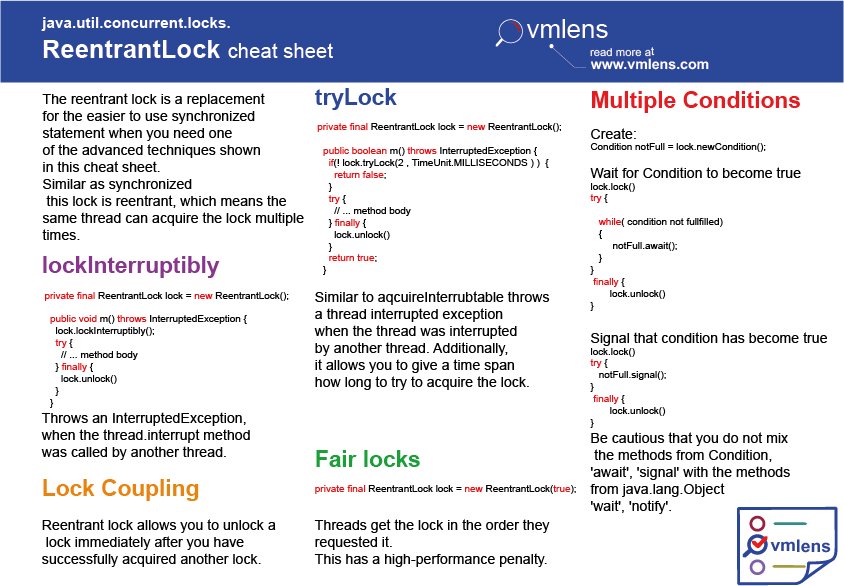ReentrantLock Cheat Sheet
This quick and easy guide will show you how to make ReentrantLocks work for you, including examples of some advanced tricks.
Join the DZone community and get the full member experience.
Join For FreeThe ReentrantLock is a replacement for the easier-to-use synchronized statement when you need one of the following advanced techniques: lockInterrupibly, tryLock, lock coupling, multiple conditions, or fair locks.
In the cheat sheet below, I summarized each technique. And in the rest of this blog post, I give a detailed description of those techniques.
Similar to synchronized statements, this lock is reentrant, which means the same thread can acquire the lock multiple times.
Lock Interruptible
private final ReentrantLock lock = new ReentrantLock();
public void m() throws InterruptedException {
lock.lockInterruptibly();
try {
// ... method body
}
finally {
lock.unlock()
}
} This throws an InterruptedException when the thread.interrupt method was called by another thread. This allows you to interrupt the processing even while trying to acquire a lock — something that is not possible with the synchronized statement.
Try Lock
private final ReentrantLock lock = new ReentrantLock();
public boolean m() throws InterruptedException {
if(! lock.tryLock(2 , TimeUnit.MILLISECONDS ) ) {
return false;
}
try
{
// ... method body
}
finally {
lock.unlock()
}
return true;
} Similar to aqcuireInterrubtable, this throws a thread interrupted exception when the thread is interrupted by another thread. Additionally, it allows you to give a time span for how long to try to acquire the lock.
This is particularly useful when you have a task that is only valid for a specific amount of time. You can also use it to avoid deadlocks. When you need to acquire two locks simultaneously acquire the locks with tryLock. If you cannot acquire one of the locks at the given interval, release both locks, wait a little bit, and try again.
Lock Coupling
The reentrant lock allows you to unlock a lock immediately after you have successfully acquired another lock, leading to a technique called lock coupling. This can, for example, be used to lock a linkedlist. You can see an implementation here.
Multiple Conditions
Create:
Condition notFull = lock.newCondition();Wait for Condition to become true:
lock.lock()
try {
while( condition not fullfilled) {
notFull.await();
}
}
finally {
lock.unlock()
} Signal that Condition has become true:
lock.lock()
try {
notFull.signal();
}
finally {
lock.unlock()
} Be cautious that you do not mix the methods from Condition, ‘await’, 'signal', with the wait and notify methods from java.lang.Object.
That's useful when you need to wait for different conditions. ArrayBlockingQueue, for example, uses two conditions one to wait that the queue becomes not full the other to wait till the queue becomes not empty.
Fair Locks
private final ReentrantLock lock = new ReentrantLock(true);Threads get the lock in the order they requested it. This has a high performance penalty (see the following benchmark for details).
Benchmark
The figure shows the throughput of synchronized vs. reentrant lock in a fair and unfair mode for different thread counts.
The benchmark was run on JDK 8 on an Intel i5 4-core CPU using jmh. The source of the benchmark can be downloaded here.
Conclusion
A reentrant lock is one of the advanced techniques used to write multithreaded Java code. Whatever technique you use, you should test the multithreaded part of your application. Read here more about testing multithreaded programs.
Published at DZone with permission of Thomas Krieger, DZone MVB. See the original article here.
Opinions expressed by DZone contributors are their own.



Comments